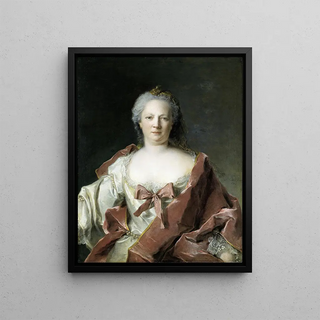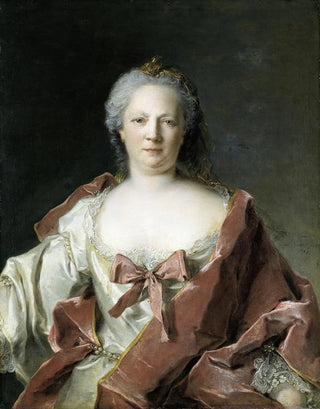Art print | Portrait of Anna Elisabeth Leerse - Jean-Marc Nattier


View from behind

Frame (optional)
Portrait of Anna Elisabeth Leerse - Jean-Marc Nattier – Captivating Introduction
The "Portrait of Anna Elisabeth Leerse" by Jean-Marc Nattier is an iconic work of the 18th century, where the finesse of the brushwork and the brilliance of the colors combine to offer a striking glimpse into French society of the era. This painting, embodying both elegance and sophistication, immerses us in a universe where beauty is celebrated and where every detail tells a story. Anna Elisabeth Leerse, a central figure in this composition, is depicted with a grace that transcends time, demonstrating Nattier's skill in capturing not only the appearance but also the essence of his subjects. Through this art print, viewers are invited to rediscover a time when art and social life intertwined harmoniously.
Style and uniqueness of the work
Nattier's style is distinguished by his ability to blend realism and refinement. In the "Portrait of Anna Elisabeth Leerse," each brushstroke seems imbued with infinite delicacy. The drapery of the dress, a deep blue, contrasts with the luminosity of the young woman's complexion, creating a visual harmony that captures the eye. The meticulous details, such as the adornments in the hairstyle and the sparkling jewelry, reveal a particular attention to accessories, symbols of status and wealth. Nattier excels in the art of female representation, offering an intimate look at his models while placing them in a setting that evokes a salon atmosphere, where intellect and aesthetics converge. This work stands out for its ability to evoke emotions while remaining rooted in a classical style, making Nattier an undisputed master of the portrait.
The artist and his influence
Jean-Marc Nattier, a French artist of the 18th century, is often regarded as one of the most influential portraitists of his time. Trained at the Royal Academy of Painting and Sculpture, he established himself thanks to his exceptional talent and keen sense of composition. Nattier was able to capture the spirit of the times, reflecting the aspirations and concerns of the nobility of his

Matte finish

View from behind

Frame (optional)
Portrait of Anna Elisabeth Leerse - Jean-Marc Nattier – Captivating Introduction
The "Portrait of Anna Elisabeth Leerse" by Jean-Marc Nattier is an iconic work of the 18th century, where the finesse of the brushwork and the brilliance of the colors combine to offer a striking glimpse into French society of the era. This painting, embodying both elegance and sophistication, immerses us in a universe where beauty is celebrated and where every detail tells a story. Anna Elisabeth Leerse, a central figure in this composition, is depicted with a grace that transcends time, demonstrating Nattier's skill in capturing not only the appearance but also the essence of his subjects. Through this art print, viewers are invited to rediscover a time when art and social life intertwined harmoniously.
Style and uniqueness of the work
Nattier's style is distinguished by his ability to blend realism and refinement. In the "Portrait of Anna Elisabeth Leerse," each brushstroke seems imbued with infinite delicacy. The drapery of the dress, a deep blue, contrasts with the luminosity of the young woman's complexion, creating a visual harmony that captures the eye. The meticulous details, such as the adornments in the hairstyle and the sparkling jewelry, reveal a particular attention to accessories, symbols of status and wealth. Nattier excels in the art of female representation, offering an intimate look at his models while placing them in a setting that evokes a salon atmosphere, where intellect and aesthetics converge. This work stands out for its ability to evoke emotions while remaining rooted in a classical style, making Nattier an undisputed master of the portrait.
The artist and his influence
Jean-Marc Nattier, a French artist of the 18th century, is often regarded as one of the most influential portraitists of his time. Trained at the Royal Academy of Painting and Sculpture, he established himself thanks to his exceptional talent and keen sense of composition. Nattier was able to capture the spirit of the times, reflecting the aspirations and concerns of the nobility of his






